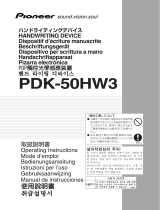
32
ENG
ESPAÑOL
PENTOUCH
PENTOUCh
Uso de Pentouch
Pentouch le permite usar las funciones
compatibles con el lápiz táctil, como Esquema,
Mi Galería, Visor de Office, Internet, Inicio de
Smart y PC Link.
ADVERTENCIA
No deje caer ni arroje el lápiz táctil y la base.
No incline el lápiz táctil y la base mientras
tenga conectado el cable de carga. Esto pu-
ede dañar el producto o provocar lesiones
personales.
Las personas que usan marcapasos deben
mantener una distancia mínima de 30 cm
con respecto al lápiz táctil. No se debe usar
donde se prohíba la comunicación inalám-
brica. Protéjalo de vibraciones extremas u
objetos magnéticos. Las comunicaciones
inalámbricas pueden provocar deficiencias o
fallas.
No use ni almacene el lápiz táctil y la base
bajo la luz solar directa, cerca de objetos cali-
entes (por ej., un calentador o una chimenea)
ni en entornos polvorientos o de mucha hu-
medad. Esto puede provocar deformaciones,
desperfectos, fallas o quemar el producto.
Si detecta algún sonido, humo u olor anor-
mal, saque de inmediato el cable de carga y
deje de usar el producto. Comuníquese con
el centro de servicios. Esto podría causar fal-
las o un incendio.
Si se observa una fuga de fluido del lápiz
táctil y la base, no toque el fluido con las ma-
nos desnudas. Si el fluido entra en contacto
con los ojos, se debe enjuagar los ojos con
abundante agua del grifo y buscar atención
médica. El fluido puede provocar ceguera.
Si el fluido entra en contacto con la piel o la
ropa, se debe lavar de inmediato con agua
del grifo. Si el fluido provoca una inflamación
o lesión cutánea, consulte al médico.
No deje que el fluido entre en contacto con
alguna llama. No introduzca el producto a un
horno microondas o de convección.
Utilice el cable USB especificado cuando
cargue la batería.
Mantenga el lápiz táctil y la base alejado del
alcance de los niños y fuera de ubicaciones
inestables. No deje que los niños ni las mas-
cotas se lleven el lápiz táctil y la base a la
boca ni que lo toquen con la lengua. Si jue-
gan con el lápiz táctil y la base o se lo tragan,
se pueden lastimar gravemente.
No use el lápiz táctil y la base con las manos
mojadas. No deje que sustancias extrañas
(por ej. gaseosas o agua) entren en con-
tacto con el lápiz táctil y la base; si eso llega
a suceder, no use el lápiz táctil y la base. No
toque el receptor óptico del lápiz táctil y la
base con un objeto puntiagudo. Esto puede
provocar una descarga eléctrica o dañar el
producto.
No use el producto en condiciones de tem-
peraturas extremas. No use el producto en
ambientes cálidos inmediatamente después
de haber dejado un ambiente frío. Esto
puede producir condensación en el lápiz.
Esto puede dañar el producto. Desconecte
la alimentación y espere varias horas antes
de usar el producto para que se evapore la
humedad.
Jamás desarme ni modifique el lápiz táctil y
la base. La garantía del producto no cubre
daños ni lesiones provocados por maniobras
no autorizadas. Esto puede provocar una
descarga eléctrica o dañar el producto.
Si se observa una fuga de fluido del lápiz
táctil y la base, se prohíbe estrictamente
el uso cerca de cualquier tipo de llama. El
fluido o el gas que se filtran pueden iniciar
un incendio o provocar daños.
Evite que el producto se vea sometido a
impactos extremos, como colocar un objeto
pesado encima o presionarlo.
No muestre caracteres ni imágenes fijas
en la pantalla durante periodos prolonga-
dos. Esto puede provocar que la imagen se
quede pegada.
No conecte el cable de carga a dispositivos
periféricos o discos que no hayan sido espe-
cificados. Esto podría causar desperfectos o
fallas.
No deje el lápiz táctil y la base en el piso. Al
pararse sobre el producto, este podría da-
ñarse o provocar lesiones personales.
Tenga cuidado cuando deba desechar el
producto. El lápiz táctil y la base se com-
ponen de una batería de polímero de litio y
material plástico. La incineración puede ser
peligrosa, así que deséchelo según las nor-
mativas locales.
No aplique demasiada fuerza para retirar el
cable de carga. Esto podría dañar el puerto
de carga y la PC.
No sostenga el lápiz táctil y la base con
demasiada fuerza. Si utiliza el lápiz táctil y
la base con una fuerza excesiva, podrían
quedar sustancias extrañas en la pantalla.
Limpie el producto con el paño de limpieza
suministrado.
Si varias personas van a usar el lápiz táctil y
la base, asegúrese de que haya suficiente
espacio. Una colisión puede provocar lesio-
nes o fallas.















































































































